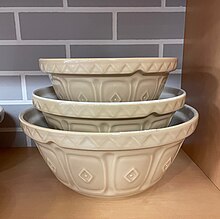
Back Steengoed AF خزف حجري Arabic Gres (ceràmica) Catalan Kamenina Czech Stentøj Danish Steinzeug German Gres Spanish Kivikeraamika ET Gres EU سنگینه FA

Stoneware is a broad term for pottery fired at a relatively high temperature.[2] A modern definition is a vitreous or semi-vitreous ceramic made primarily from stoneware clay or non-refractory fire clay.[3][4] End applications include tableware, decorative ware such as vases.
Stoneware is fired at between about 1,100 °C (2,010 °F) to 1,300 °C (2,370 °F). Historically, reaching such temperatures was a long-lasting challenge, and temperatures somewhat below these were used for a long time.[5]

It was developed independently in different locations around the world, after earthenware and before porcelain. Stoneware is not recognised as a category in traditional East Asian terminology, and much Asian stoneware, such as Chinese Ding ware for example, is counted as porcelain by local definitions.[6] Terms such as "porcellaneous" or "near-porcelain" may be used in such cases. Traditional East Asian thinking classifies pottery only into "low-fired" and "high-fired" wares, equating to earthenware and porcelain, without the intermediate European class of stoneware, and the many local types of stoneware were mostly classed as porcelain, though often not white and translucent.[7]
One definition of stoneware is from the Combined Nomenclature of the European Communities, a European industry standard. It states:
Stoneware, which, though dense, impermeable and hard enough to resist scratching by a steel point, differs from porcelain because it is more opaque, and normally only partially vitrified. It may be vitreous or semi-vitreous. It is usually coloured grey or brownish because of impurities in the clay used for its manufacture, and is normally glazed.[4][8]
- ^ "Tea Bowl with "Hare's-Fur" Glaze". Metropolitan Museum of Art. 2012-11-30. Retrieved 2013-02-19.
- ^ Clay vitrifying temperatures
- ^ Standard Terminology of Ceramic Whiteware and Related Products: ASTM Standard C242.
- ^ a b Arthur Dodd & David Murfin. Dictionary of Ceramics; 3rd edition. The Institute of Minerals, 1994.
- ^ Medley, Margaret, The Chinese Potter: A Practical History of Chinese Ceramics, p. 13, 3rd edition, 1989, PhaidonISBN 071482593X
- ^ Valenstein, S. (1998). A handbook of Chinese ceramics, p. 22, Metropolitan Museum of Art, New York. ISBN 9780870995149
- ^ Valenstein, S. (1998). A handbook of Chinese ceramics, pp. 22, 59-60, 72, Metropolitan Museum of Art, New York. ISBN 9780870995149
- ^ Though "normally glazed" is not true for many historical and modern examples.